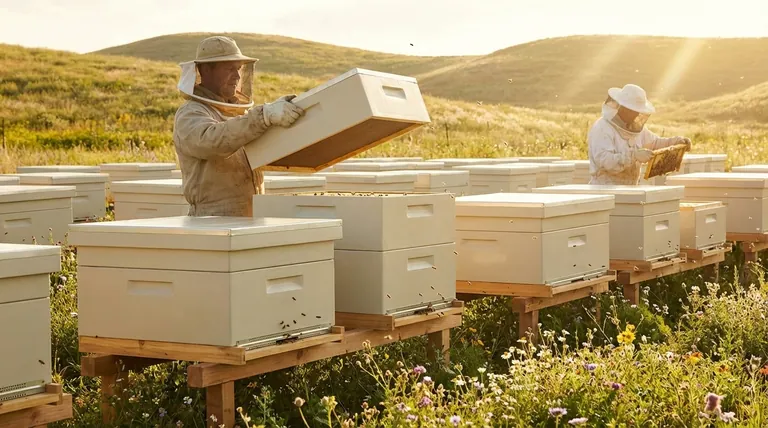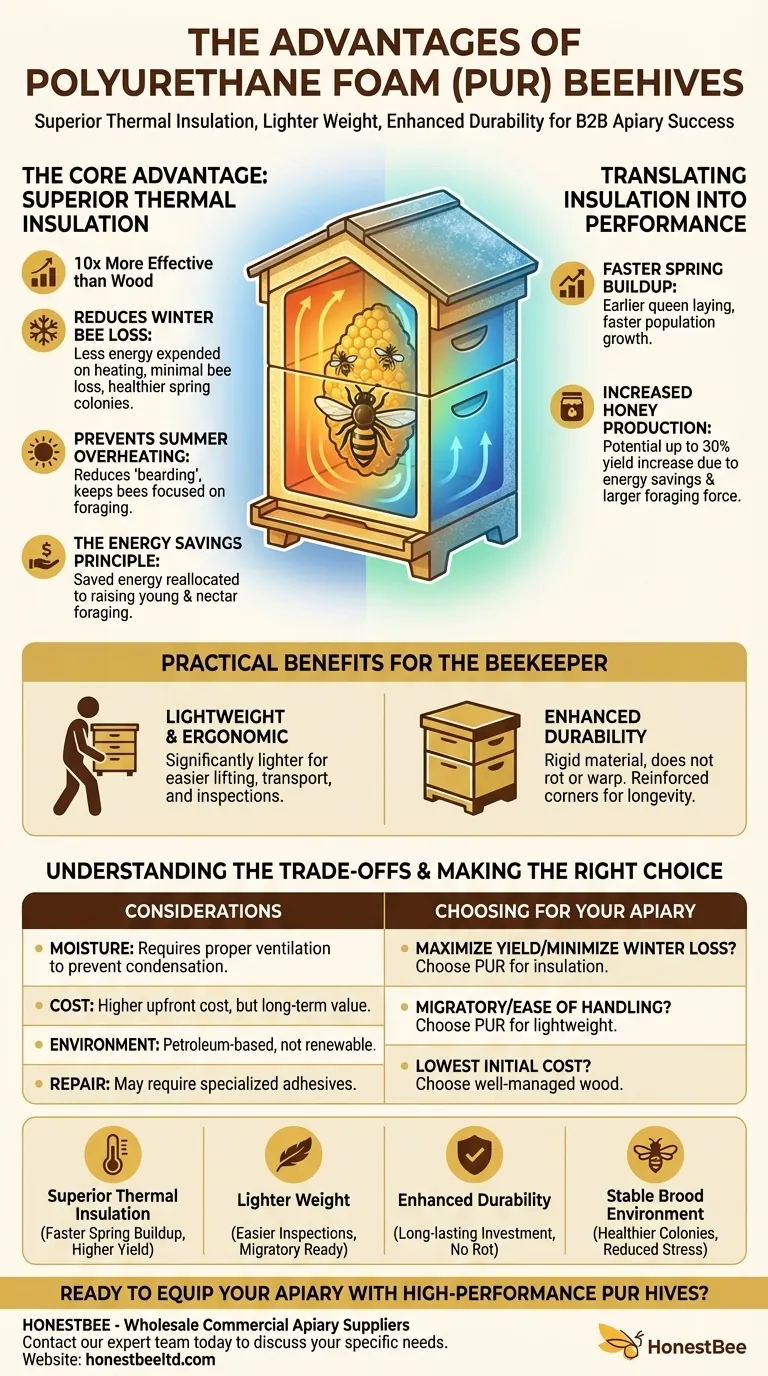In short, the primary advantages of polyurethane foam (PUR) beehives are superior thermal insulation, lighter weight, and enhanced durability. These characteristics create a more stable internal environment for the bees, which can lead to reduced colony stress, lower winter losses, and significantly increased honey production.
The core benefit of polyurethane hives is not the material itself, but how it reduces the energy bees must expend on thermoregulation. By creating a highly insulated home, PUR hives allow the colony to redirect that energy toward faster population growth and greater honey storage.

The Core Advantage: Superior Thermal Insulation
Polyurethane is an exceptional insulator, stated to be ten times more effective than traditional wood. This thermal efficiency is the foundation for nearly all other benefits.
Reducing Winter Bee Loss
In cold climates, bees must vibrate their flight muscles to generate heat, forming a tight cluster to survive. This requires a tremendous amount of energy, consumed from their winter honey stores.
A PUR hive drastically reduces heat loss, meaning the winter cluster needs to expend far less energy to maintain its core temperature. This directly results in minimal bee loss and healthier colonies emerging in spring.
Preventing Summer Overheating
Insulation works both ways. During hot summer days, the same thermal barrier that keeps heat in during winter now keeps excessive heat out.
This prevents the colony from overheating and reduces the need for "bearding," where large numbers of bees congregate outside the hive to cool down. It keeps more bees focused on foraging and in-hive tasks.
The Energy Savings Principle
Every ounce of energy a colony saves on heating or cooling is energy it can reallocate. Bees in PUR hives can dedicate more resources to raising young and foraging for nectar.
Translating Insulation into Performance
The stable, low-stress environment created by a PUR hive has a direct and measurable impact on colony performance and productivity.
Faster Spring Buildup
Colonies in polyurethane hives often begin their spring development earlier. The queen can start laying sooner because the ambient temperature inside the hive is warmer and more stable, allowing the brood to be kept at the optimal temperature with less effort.
This head start allows the colony to build its population faster, ensuring a maximum workforce is ready for the main nectar flow.
Increased Honey Production
The combination of energy savings, faster buildup, and a larger foraging force is why sources claim a potential honey yield increase of up to 30% compared to traditional hives. When bees aren't burning through honey stores to stay warm, that honey remains as surplus for the beekeeper.
Practical Benefits for the Beekeeper
Beyond colony health, polyurethane hives offer tangible advantages in apiary management.
Lightweight and Ergonomic Design
PUR hives are significantly lighter than their wooden counterparts. This makes lifting hive bodies, moving hives for migratory beekeeping, and general inspections far less strenuous for the beekeeper.
Enhanced Durability and Longevity
High-density polyurethane is a rigid, monolithic material that does not rot or warp like wood. Many designs feature reinforced corners with plastic inserts, allowing the use of hive tools for prying frames without damaging the hive body. This resilience makes them a long-lasting investment.
Understanding the Trade-offs
While the benefits are compelling, a complete analysis requires acknowledging the potential downsides and considerations.
Moisture Management and Ventilation
Wood is a porous material that "breathes," allowing some moisture to escape. Polyurethane is non-porous. This means moisture generated by the colony can condense on the inner walls if ventilation is inadequate, potentially leading to mold or stressed bees. Proper ventilation is critical in PUR hives.
Upfront Cost vs. Long-Term Value
Polyurethane hives typically have a higher initial purchase price than basic wooden hives. This cost must be weighed against the long-term benefits of durability, lower bee replacement costs, and potentially higher honey yields.
Environmental Considerations
Polyurethane is a petroleum-based plastic. While it is durable and long-lasting, it is not a renewable resource like wood. The environmental footprint of its production and end-of-life disposal is a factor for some beekeepers.
Repair and Maintenance
Repairing a damaged wooden hive is often a simple matter of wood glue and nails. Repairing a crack or significant gouge in a polyurethane hive can be more complex and may require specialized adhesives.
Making the Right Choice for Your Apiary
The best hive material depends entirely on your specific goals, management style, and climate.
- If your primary focus is maximizing honey yield and minimizing winter losses: The superior insulation of polyurethane makes it an exceptionally strong choice, especially in climates with harsh winters.
- If your primary focus is migratory beekeeping or ease of handling: The lightweight nature of PUR hives offers a significant practical advantage over heavy wooden equipment.
- If your primary focus is lowest initial cost and traditional methods: Well-managed wooden hives remain a perfectly viable and effective option, with the potential to add insulation wraps for improved wintering.
Ultimately, choosing the right equipment is about understanding the principles of bee biology and selecting the tool that best helps your colonies thrive.
Summary Table:
| Key Advantage | Impact on Your Apiary |
|---|---|
| Superior Thermal Insulation | Reduces bee energy expenditure, leading to faster spring buildup and higher honey yields. |
| Lighter Weight | Makes hive inspections and migratory beekeeping significantly easier and less strenuous. |
| Enhanced Durability | Resists rot and warping, offering a long-lasting investment compared to traditional wood. |
| Stable Brood Environment | Promotes healthier, less-stressed colonies with reduced winter losses. |
Ready to equip your apiary with high-performance polyurethane beehives?
At HONESTBEE, we supply commercial apiaries and beekeeping equipment distributors with the durable, efficient equipment needed to maximize honey production and ensure colony health. Our wholesale-focused operations are designed to support your business's growth and success.
Contact our expert team today to discuss your specific needs and discover how our beekeeping supplies can benefit your operation.
Visual Guide

Related Products
- Professional Galvanized Hive Strap with Secure Locking Buckle for Beekeeping
- HONESTBEE Professional Long Handled Hive Tool with Precision Cutting Blade
- Professional Grade Foldable Beehive Handles
- Professional Drop-Style Hive Handles for Beekeeping
- Professional Hive Top Bee Feeder for Beekeeping
People Also Ask
- Can straps with hook ends be used for beehives? A Guide to Secure Hive Management
- Why are hive straps important for beekeepers? Secure Your Hives Against Wind, Predators & Transport
- What are the types of Emlocks available? Choose the Right Strap for Hive Security
- What is the best length for straps used around beehives? Why 12 Feet is the Industry Standard
- How can beekeepers secure the top cover of a hive? Protect Your Colony from Wind and Weather



















